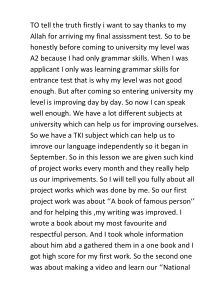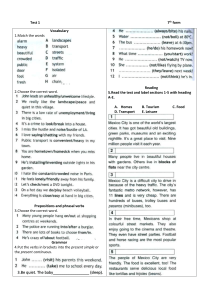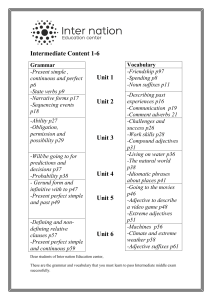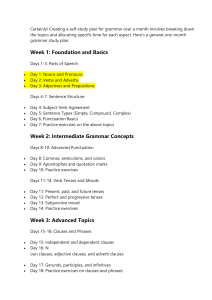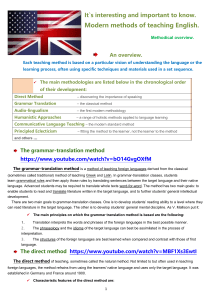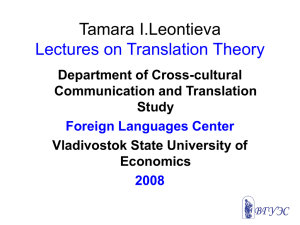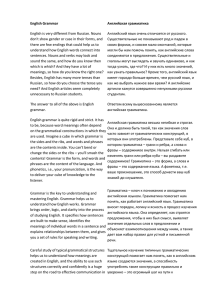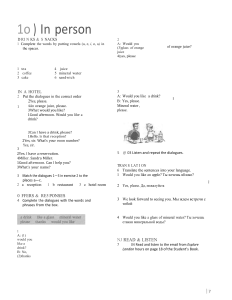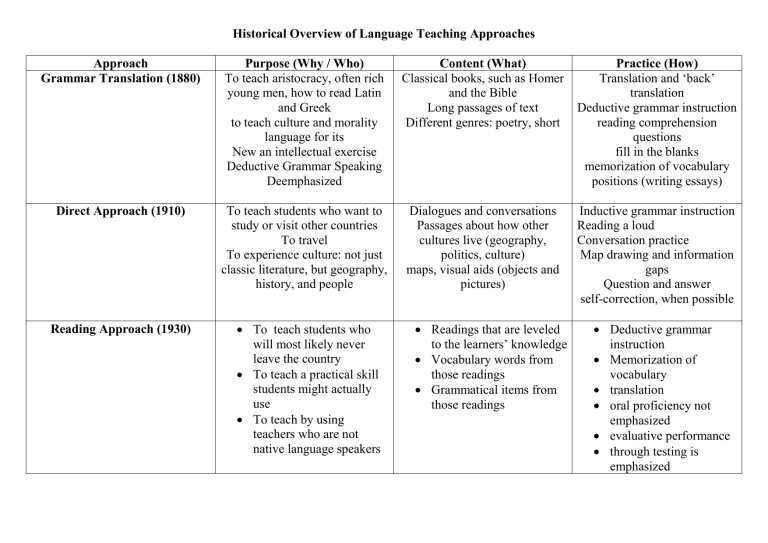
Historical Overview of Language Teaching Approaches Approach Grammar Translation (1880) Purpose (Why / Who) To teach aristocracy, often rich young men, how to read Latin and Greek to teach culture and morality language for its New an intellectual exercise Deductive Grammar Speaking Deemphasized Content (What) Classical books, such as Homer and the Bible Long passages of text Different genres: poetry, short Practice (How) Translation and ‘back’ translation Deductive grammar instruction reading comprehension questions fill in the blanks memorization of vocabulary positions (writing essays) Direct Approach (1910) To teach students who want to study or visit other countries To travel To experience culture: not just classic literature, but geography, history, and people Dialogues and conversations Passages about how other cultures live (geography, politics, culture) maps, visual aids (objects and pictures) Inductive grammar instruction Reading a loud Conversation practice Map drawing and information gaps Question and answer self-correction, when possible Reading Approach (1930) To teach students who will most likely never leave the country To teach a practical skill students might actually use To teach by using teachers who are not native language speakers Readings that are leveled to the learners’ knowledge Vocabulary words from those readings Grammatical items from those readings Deductive grammar instruction Memorization of vocabulary translation oral proficiency not emphasized evaluative performance through testing is emphasized Audio-lingual Approach (1940) To teach soldiers how to speak so they can communicate with enemies and partners to teach anyone who needs to connect orally/aurally Visual supports (objects and pictures) dialogues language mimicry Habit formation drills: chain, single and multi-slot substitution, transformation Dialog memorization use of minimal pairs grammar games overlearning Cognitive Approach (1960) to comprehend how languages work to inquiry and publish to recognize the unique properties of the human mind not truly a classroom approach. A way of understanding a learner Instead of techniques, experts focused on characteristics of the students' brains and strategies they can use to improve their learning. Affective Humanistic (1970) to respect student feelings as they learn a language to increase the speed of learning bright pictures, posters everywhere music and fine art dialogues games Positive supporting Choosing a new identity Multiple certs: reading a dialogue with music in the background and playing it multiple times spontaneous, creative thought through dramatic interpretations, games, singing and dancing Comprehension Approach (1980) To help make meaning clear (to make input comprehensible) To help learners benefit confidence so that they are willing to produce language. classroom objects: a door, a table, a chair. Visible actions: jump, sit, walk Use of aids Role reversal Action chain Communicative Approach (1980) To connect people together in order to create opportunity and awareness. To like other cultures and places To utilise a language Carefully leveled books with Use of authentic materials high interest themes Pictures trips Books often contain four skills: Information gap exercises reading, writing, listening and Language games speaking Group and pair work Books also contain exception pronunciation, grammar culture, learner strategies, speech acts, and vocabulary
